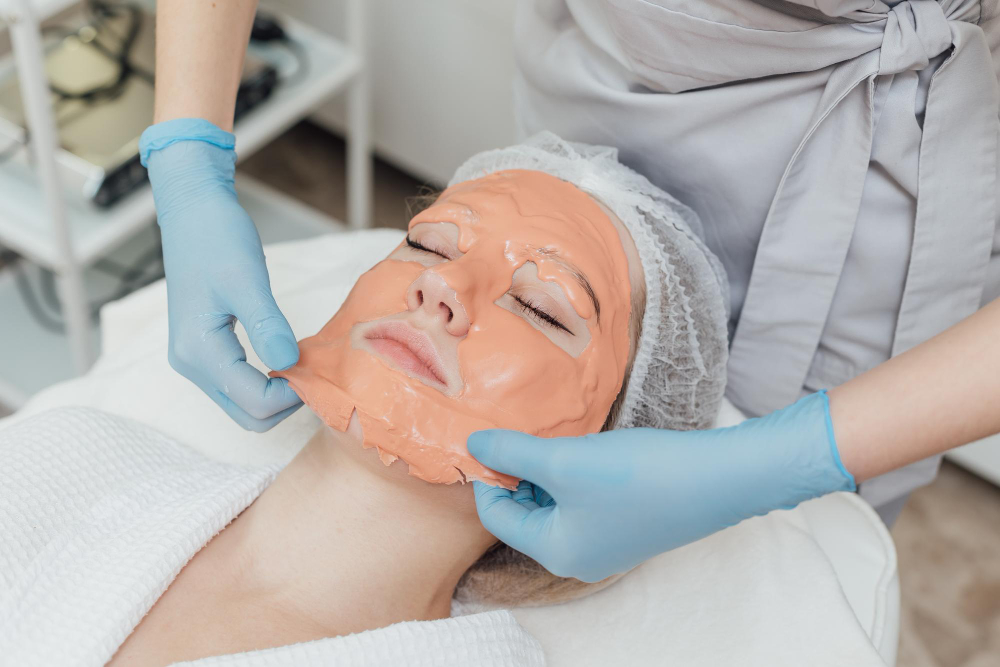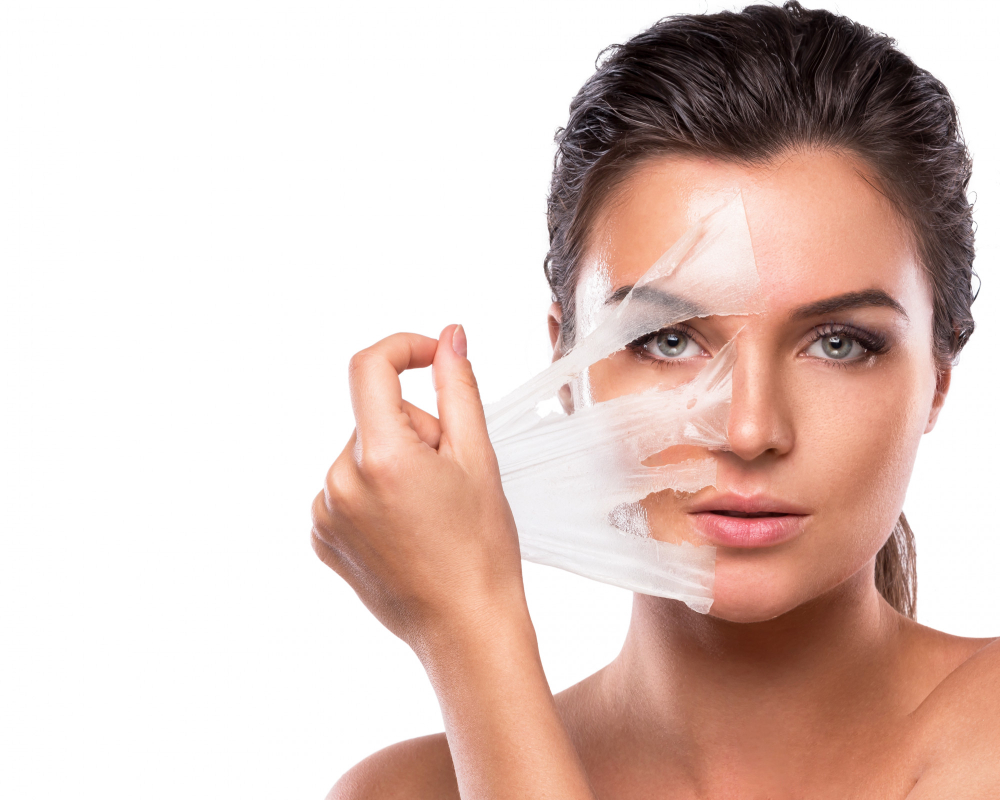Chemical Peels
A chemical peel is a treatment that involves using a chemical solution to remove layers of skin and reveal younger-looking skin beneath. This procedure can help to decrease or enhance the appearance of fine lines, wrinkles, acne, scars, uneven skin tone, and other imperfections. The choice of chemical used will determine the depth of the peel and the specific skin condition it targets.

Types of chemical peel
A chemical peel is a treatment that improves the surface of the skin. Depending on your specific concerns, you can select a chemical peel of one of three intensities to target the desired issues.
- A light chemical peel is a type of treatment that involves removing the top layer of skin, known as the epidermis. This procedure is commonly used to address concerns such as fine wrinkles, acne, uneven skin tone, and dryness. It is recommended to have a light peel done every two to five weeks.
- A medium chemical peel is a treatment that eliminates skin cells from the top layer of your skin (epidermis) as well as some areas of the middle layer (dermis). It is commonly used to address wrinkles, acne scars, and uneven skin tone. It may be necessary to undergo multiple sessions of the procedure in order to obtain or sustain the desired outcome.
- A deep chemical peel is a procedure that eliminates skin cells at a much deeper level. It is typically suggested by your doctor to address more pronounced wrinkles, scars, or precancerous growths. Unlike other treatments, you will not require multiple procedures to achieve the desired outcome.
Chemical peels are unable to eliminate deep scars or wrinkles, nor can they effectively tighten sagging skin.

Types of acid
Chemical peels may consist of various acid types, such as:
- Alpha-hydroxy acids, such as glycolic acid, lactic acid, and citric acid, are commonly found in at-home exfoliating treatments.
- One type of beta-hydroxy acids is salicylic acid, which is particularly advantageous for individuals with acne-prone skin and enlarged pores.
- Dermatologists commonly employ trichloroacetic acid in medium or deep chemical peels.
- Phenol, a potent chemical substance, proves to be valuable for performing deep peels.
The dermatologist might refer to the white coating developed on the skin as “frosting,” caused by certain chemicals found in peels.
The occurrence of frosting indicates that the peel is reaching its final stage. The doctor can determine the success of the peel by assessing the presence and amount of frosting. There are three degrees or levels of frosting.
- patches of white coating over red skin
- a blanket of white covering accompanied by a visible redness beneath
- an extensive white coating with minimal signs of redness
Who Is a Good Candidate For a Chemical Peel?
Typically, individuals with fair skin and light hair are more suitable candidates for chemical peels. However, individuals with darker skin can also achieve positive outcomes, depending on the specific issue being addressed. Nonetheless, there is a possibility of experiencing an irregular skin tone following the procedure.
Chemical peels are not effective in treating skin that sags, bulges, or has deep wrinkles. In such cases, alternative cosmetic procedures like laser resurfacing, facelift, brow lift, eyelid lift, or the use of collagen or fat fillers may be necessary. Consulting with a dermatologic surgeon will help determine the best treatment option for your specific needs.
How do you prepare for a chemical peel?
Prior to your procedure, you will have an initial meeting with a skincare expert. This consultation will assist in identifying the most suitable treatment option for you. The specialist will provide information on the specific peel you will receive and inquire about any factors that may potentially affect the peel’s effectiveness. This could involve questions about acne medication usage and your tendency to develop scars easily.
Before a chemical peel, you must:
- Do not apply any kind of retinol or retin-A cream for a minimum of 2 days.
- It is important to let your skincare specialist know about any medications you are currently taking.
- have not taken Accutane for a minimum of six months
What should you expect during the procedure?
A chemical peel can be obtained either at a medical office or a surgical facility. This procedure is done on an outpatient basis, which means there is no need to stay overnight.
In order to do a peel, the expert will start by thoroughly cleansing your skin. After that, they will administer one or multiple chemical solutions, like glycolic acid, trichloroacetic acid, salicylic acid, lactic acid, or carbolic acid (phenol), to specific parts of your skin. This process creates a controlled injury, allowing new skin to regenerate.
While undergoing a chemical peel, individuals typically experience a brief period of intense heat lasting approximately five to ten minutes, which is then followed by a stinging sensation. Applying cool compresses to the skin may help alleviate this stinging sensation. In the case of a more extensive peel, it may be necessary to take pain medication during or after the procedure to manage any discomfort.

Post-procedure experience
Following a chemical peel, it is common for your skin to become red and show signs of irritation. If the chemical peel is more intense, the redness and swelling may be more pronounced. You may also experience ongoing burning or stinging sensations, which is normal. To alleviate these discomforts, you can apply a protective ointment like petroleum jelly to the affected area. Typically, these symptoms should start to subside within one to two weeks.
For light peels, it is typically acceptable to wear makeup the day after the treatment, while for medium peels, it is advised to wait for about a week. It may take several months for the skin to fully heal and reveal the final outcome of the peel. To maintain the results of the chemical peel, it is recommended to regularly cleanse, moisturize, and minimize sun exposure.
Chemical peels are an efficient and affordable technique to refresh the skin. The key aspect of a successful chemical peel is to select the right peeling agent that aligns with the patient’s goals. To decide the most suitable treatment plan, your doctor will evaluate the advantages and potential drawbacks.
Ways to Protect and Nurture Your Skin Following a Chemical Peel
Chemical peels performed by a highly qualified esthetician are a safe and effective way to revamp your appearance and eliminate scars or signs of aging. However, for best results, you need to properly care for your skin after treatment.

Here are some tips to follow:
- To prevent any negative side effects after your chemical peel, it is recommended to refrain from using hot water for at least a week. During this initial week, avoid washing your face or taking showers with hot water as it can lead to post-inflammatory hyperpigmentation. Moreover, the steam from hot water can open your pores, increasing the likelihood of infections.
- Allow your skin to naturally shed after a chemical peel. It is crucial to refrain from touching your face in order to avoid scarring. The recommended approach is to let your skin peel off on its own.
- Treat your skin delicately and steer clear of exfoliating. After getting a chemical peel, the skin’s protective layer will temporarily weaken. This implies that you should avoid using any cleansing products that contain exfoliators, like facial scrubs, until your skin has fully recovered. When drying your skin, abstain from rubbing it vigorously; instead, softly pat it dry using a gentle towel.
- It is important to always apply sunscreen and reduce your time spent under the sun. Your face is incredibly sensitive after a chemical peel, so it’s best to stay away from direct sunlight for a few days. If you do go outside, remember to use sunscreen and stay in shaded areas. It is recommended to use sunscreen for at least six weeks following your chemical peel.
Having Chemical Peels in Turkey?
24px
The patient must carefully search for an appropriate service provider, have information, and ask about the surgeon and his experience. And also, checking examples of his previous operations.
Accordingly, we encourage you to contact the Health & Beauty to obtain all information and details, and to ensure that you have your operation done by the hands of the most skilled doctors working in this specialty.

